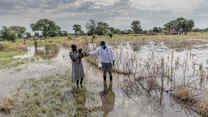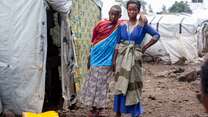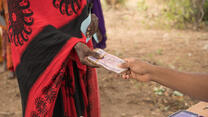The dialogue leading up to the World Humanitarian Summit has cast a spotlight on humanitarian cash transfers as a means to improve efficiency in the humanitarian system and improve outcomes for crisis- affected people. The U.N. Secretary-General Ban Ki-moon has called for cash-based programming to be the default method of support for affected populations,and various high-level panels have called for broad scale-up of cash transfers in humanitarian programming. But is it actually possible to safely distribute cash to the millions of people displaced from their homes or impacted by disaster across the world each year?
To realize a global scale-up in cash transfers, countries facing crises must have the necessary infrastructure and financial services in place to make payments safely and efficiently. Electronic payment (e-payment) mechanisms, including mobile money and card-based solutions such as prepaid debit cards, offer efficient and scalable means to deliver cash, improve transparency, and mitigate fraud. Their scale-up would contribute to greater financial inclusion, particularly of women who represent over half of the 2.5 billion adults in the developing world considered ‘financially excluded’. E-payment tools are increasingly common, but not present in all countries, especially those with weak digital and financial infrastructure or regulatory environments.
To begin addressing this impediment to delivering cash at scale in emergencies, the IRC commissioned two linked research projects to understand how better to prepare for scaled-up humanitarian cash transfers.
The first report, Making Electronic Payments Work for Humanitarian Response, investigates the current state of readiness of e-payment systems to deliver emergency cash transfers. The paper explores the extent to which existing resilience and digital finance efforts prepare e-payment systems to meet the specific needs of humanitarian agencies when disasters strike.
In doing so, the IRC proposes a framework to comprehensively analyze e-payment preparedness at the country level, and evaluated six countries to identify their level of readiness and the activities needed to strengthen e-payment responsiveness to shocks.
The second report, Untapped Humanitarian Demand: A Business Case for Expanding Digital Financial Services, uses a return on investment (ROI) model to estimate whether or not a business case exists for expanded coverage of digital financial services in crisis- prone areas. By modeling the potential
ROI for DFS providers from meeting aggregate humanitarian demand, this paper aims to motivate greater investment in digital financial services in areas vulnerable to emergencies, incentivize humanitarian-private sector cooperation prior to crises, and encourage development and humanitarian actors to coordinate their respective DFS-related initiatives.
Key findings
When considered together, the findings from these reports provide incentives and motivation to address the gaps in the current state of e-payment preparedness in disaster-prone countries.
- Incredible progress has been made in bringing last mile voice and data connectivity to low-income countries and making accessible financial services to more people than ever before. There is a strong body of experience from which to draw learning on what works to expand e-payment systems.
- Those countries where emergencies are the most likely, are often the least well prepared to scale- up e-payments due to poor infrastructure and regulatory systems.
- There is a range of e-payment readiness across disaster-affected countries, but even strong e-payment systems require preparedness efforts to effectively respond in crises.
- There is a business case to expand e-payment services in crisis-prone areas. Doing so can provide a positive return, extend banking services to the most vulnerable, and improve response capacity.
- There is a wide scope for innovative partnerships between humanitarian, development, private sector and national governments to better prepare e-payment systems to meet the needs of humanitarian actors.



